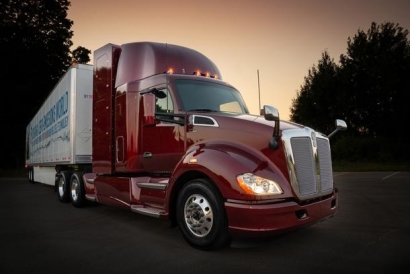
The new truck, known internally as "Beta," expands on the capabilities of Toyota’s first Project Portal test vehicle by increasing the estimated range to more than 300 miles per fill. The truck also has an added sleeper cab and a unique fuel cabinet combination that further increases cab space without increasing wheelbase.
Since it first began operation in April 2017, the Project Portal “Alpha” truck has logged nearly 10,000 miles of testing and real-world drayage operations in and around the Ports of Long Beach and Los Angeles in California while emitting nothing but water vapor. The Beta vehicle will begin drayage operations in the fall, increasing the Ports’ zero emission trucking capacity and further reducing the environmental impact of drayage operations.
Project Portal 2.0 builds on the lessons learned from the launch of the Alpha vehicle in 2017. The first heavy-duty truck was the result of a true skunkworks effort within Toyota that moved from initial concept to a fully-capable drayage truck driving silently out of a Michigan garage in just over a year. Engineers and technicians worked long hours to reconfigure the wire harnesses, electronics and other components of two off-the-lot Mirai fuel cell electric cars to create one of the world’s first OEM-built zero-emission heavy trucks.
With a gross combined weight capacity of 80,000 lbs. and a driving range of more than 200 miles per fill, the 670-plus horsepower Alpha truck produces 1325 pound-feet of torque from two Mirai fuel cell stacks and a 12kWh battery. Project Portal Beta maintains these torque and horsepower numbers while also extending the range of the vehicle and pushing forward on other key performance metrics.
"We needed to move beyond a proof of concept, which the first truck accomplished, to something that is not only better than the original but is also more commercially viable," said Andrew Lund, chief engineer for the project.
Over 16,000 pollution-emitting trucks are working in Ports of Long Beach and Los Angeles, a number that is estimated to balloon to 32,000 by 2030. More than 43,000 drayage trucks are in operation at ports across the United States, contributing significant amounts of carcinogens, diesel particulate matter (DPM) and other pollutants into the air of port communities and surrounding neighborhoods.
“Our goal with the first truck was to see if it could be accomplished, and we did that,” said senior manager for Toyota’s North American Electrified Vehicle & Technologies Office, Craig Scott. “This time we're looking at commercial viability. We want to help make a difference—a significant difference when it comes to the air quality not only in the LA area, but across the U.S. and around the globe."

